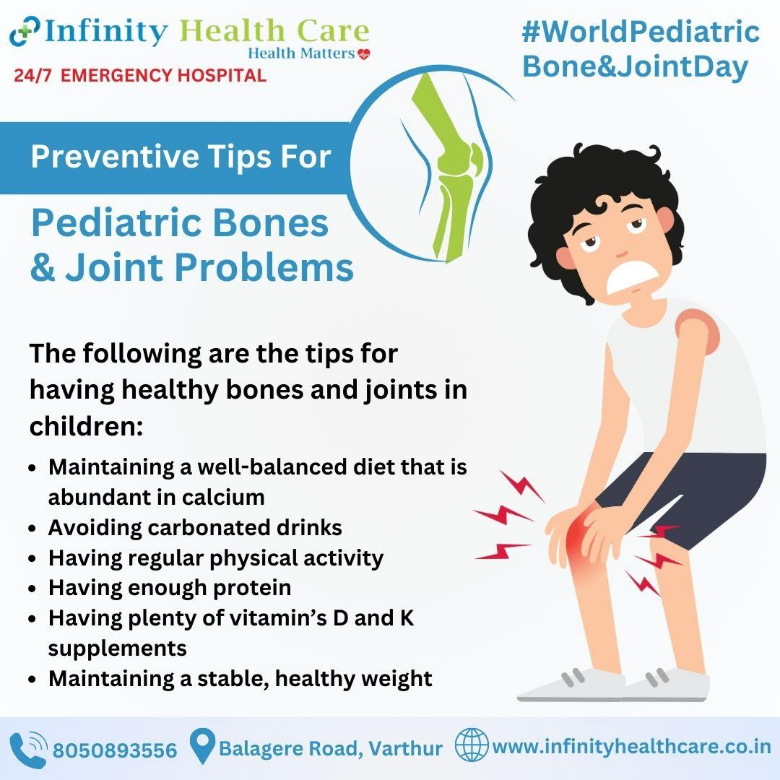World Paediatric Bone and Joint Day is a global healthcare event celebrated on the 19th of October every year to spread awareness about the impact of musculoskeletal conditions among children.
On this day, various local, national, and international organizations come together and conduct several events, educational seminars and conferences that aids in spreading awareness about the impact of pediatric musculoskeletal disorders.
World Pediatric Bone and Joint Day occurs every October 19. According to the American Academy of Orthopedic Surgeons, more than 126 million Americans are impacted by musculoskeletal conditions. Many cases are brought on by obesity developed during childhood. World Pediatric Bone and Joint Day highlights obesity, screening, and prevention. The day also looks at symptoms, treatment, and economic impact.
While the first Pediatric Bone and Joint Day — or PB&J Day — wasn’t celebrated until 2012, orthopedic medicine has far longer roots. Originally, the term “orthopedic” referred specifically to the correction of musculoskeletal deformities in children. Nicolas Andry, who was a professor of medicine at the University of Paris, coined the term in his textbook published in 1741. This book, which was directed towards parents, advocated for exercise, manipulation, and splinting to treat child bone deformities. 40 years later, In 1780, Jean-Andre Venel opened the first orthopedic institute, which was dedicated to treating children’s skeletal deformities.
The modern hip replacement was introduced in the 1960s by English tribologist Sir John Charnley, who made the connection that implants can be used to replace joint surfaces. He designed a one piece stainless steel femoral stem & head and an acetabular component, both of which were used to fix the bone along with bone cement. The Charnley Low Friction Arthroplasty and designs that evolved from it were used for over two decades for hip replacement procedures. In the 1970s knee replacements, using similar technology, commenced for patients with rheumatoid arthritis.
USSR doctor, Gavril Abramovich Ilizarov, made a major contribution to orthopedic procedures without much training in the specialized field. Sent to look after Russian soldiers in 1950s Siberia, he came face to face with crippling conditions, infections, and bone malalignments. Employing the assistance of a nearby bicycle shop, he invented external ring fixators, similar to the spokes on a bike. With this, he was able to heal, realign, and lengthen to an unprecedented degree. The Ilizarov apparatus is still used by surgeons to this day.
Don't feel like you need to give them advice, but at least offer them some resources that are available. Sometimes, just knowing someone is in their corner can be just the catalyst they need to seek treatment.
The Bone and Joint Initiative has printable posters on their website. Print a few out and spread them around your child's school, a neighborhood store, or community center. The two kinds of posters explain the basics of bone and joint health in both English and Spanish.
There are all kinds of online resources for families dealing with pediatric bone and joint problems. Help get those resources to the people that need them.
Children around the world experience bone and joint problems. This day strives to help those with and without them learn about the causes, symptoms, and treatments.
Childhood obesity is a big contributor to bone and joint problems both as a child and later in life. Understanding the long-term consequences and learning techniques to lose weight contribute to preventing problems in the first place.
Childhood obesity also causes many other health problems, like diabetes and heart disease. Understanding one of the repercussions of obesity like bone and joint problems, can help clarify the larger problem.

The following are the tips for having healthy bones and joints in children:
Maintaining a well-balanced diet that is abundant in calcium
Avoiding carbonated drinks
Having regular physical activity
Having enough protein
Having plenty of vitamin’s D and K supplements
Maintaining a stable, healthy weight
To reach us please contact on Phone No.8050893556, Balagere Road,Varthur, Email – contactinfinityhealthcare@gmail.com and Website - www.infinityhealthcare.co.in
Written By
Infinity Health Care